
- Red Search
- Resources
- WordPress Statistics
WordPress Statistics: Growth, Forecast & Usage Insights
-
 Daniel Law
Daniel Law
WordPress stands tall among all CMS, allowing you to create, design, and manage your website even without extensive coding knowledge. As it became the go-to choice for millions of businesses, this popular platform helps countless businesses go online and reach infinite potential.
Let’s delve into the latest WordPress statistics and trends, exploring why this highly versatile platform is the clear choice for millions to succeed online.
What is WordPress & Why Does It Dominate the CMS Market?
Initially created as a blogging platform, WordPress is an open-source CMS software for creating websites and complex web applications. While this software is downloadable for free, you still need a web hosting plan and a domain name to build a WordPress website.
WordPress is the most popular website-making platform, powering nearly half of all websites in the digital sphere. It’s important not to mistake this software for WordPress.com, a web hosting solution.
Aside from its open-source nature, WordPress continues to dominate the CMS market due to its rich suite of plugins and themes that fit different website types. Its extensive customisation options, flexibility, and robust community support have made it the top choice for bloggers, businesses, and enterprise-level users.
WordPress Market Share & Usage Statistics
WordPress has remained a digital behemoth for two decades, but why is it the premier choice for anyone looking to create a website? Its compelling edge lies in the numbers, from its market share dominance and incredible growth rates that show no sign of slowing down in 2025.
How Much of the Internet Runs on WordPress?
WordPress is the undisputed leader in website creation, powering 43.6% of all websites. Over 488.8 million of the 1.19 billion websites worldwide use WordPress, roughly 2 out of 5 websites you visit.
WordPress’ sheer scale completely dominates the market, with its closest competitor having a ten-times smaller market share. Based on the chart, combining all its popular rival CMS platforms accounts for 12.5% of all websites, which is still 30% short of outranking WordPress.
As WordPress usage increases by 12% yearly, it’s not long enough that it powers half of all websites on the Internet.
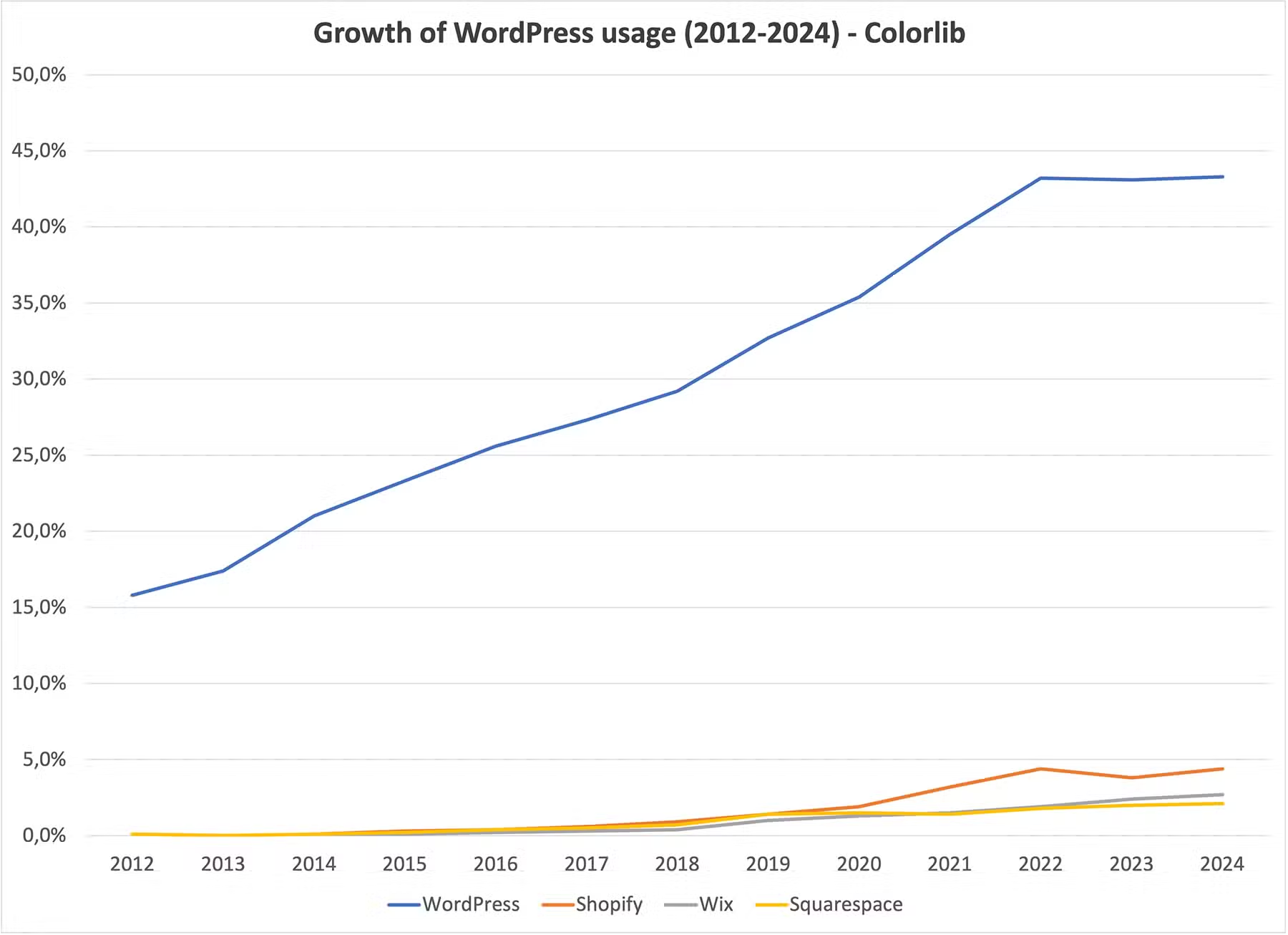
Source: Colorlib
How Many Top Websites Use WordPress?
How do WordPress sites thrive in over a billion websites? In the realm of high-traffic sites, WordPress commands 22.52% of the top 1 million sites globally. Remarkably, it powers 25.55% of the world’s top 100k websites.
As it stands prominently, WordPress is behind 25% of the top 10k websites worldwide. This versatile platform is still the biggest player in these segments, with over 10,000 WordPress websites published daily.
WordPress is far from being dethroned soon, as competitor platforms like Shopify and Squarespace build only 60-80 sites daily. Despite being the leading competitors in the CMS market, these two only occupy less than 2% of the top 10k live websites.
WordPress Usage by Industry
Since WordPress.com blogs have 409 million viewers monthly, building your site could reach this massive audience. WordPress usage in the tech industry has been predicted to rise by 15% in 2024 compared to previous years.
Blogs, media, e-commerce, education, and healthcare industries have continuously leveraged WordPress to scale online visibility. According to WP Engine’s study, WordPress generates a substantial percentage of business for organisations of all sizes.

Similar data suggests that 89% of surveyed users believe that the WordPress community will continue to grow in the next five years as digitisation expands. This reflects why renowned global brands rely on WordPress for diverse online ventures.

Source: Website Builder
Growth Trends: Why is WordPress Still Growing in 2025?
WordPress’s market share is on a rocket ship as the digital world moves at lightning speed. Let’s understand by the numbers how this platform will reign supreme in 2025 and beyond.
Year-on-Year Growth Statistics for WordPress
An analysis from W3Techs outlines that WordPress market share has consistently grown since 2013. While over two-thirds of websites were hand-coded (without CMS) a decade ago, this has dwindled as WordPress adoption increased each year.
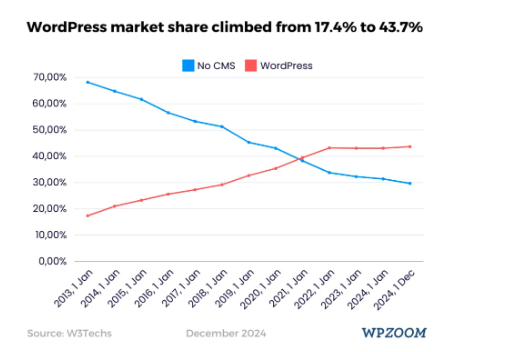
With the growing preference for CMS-driven website development, WordPress’s market share climbed from 17.4% (2013) to 43.7% (2024). This is projected to increase by 10.3% in 2025-2028, solidifying its dominance with the shift towards CMS usage for web development.
Why Businesses Keep Choosing WordPress
WordPress has maintained its leadership position in the CMS market despite the influx of new tools. Here are a few standout features why businesses continue to opt for WordPress:
- Customisation: The WordPress directory offers over 13,000 free themes and over 59,000 free plugins, giving you unparalleled options to alter your site’s visuals and extend features that fit your business branding and style.
- SEO-Friendliness: WordPress provides clean code, customisable URLs (permalinks), and built-in features to optimise your website search results. These enhance your site’s search ranking to boost organic traffic, leads, and sales.
- Integration Capabilities: The platform integrates seamlessly with third-party apps and e-commerce tools, streamlining workflow without switching platforms.
How WordPress Adapts to Market Demands
Latest estimates reveal that about 54% of global users browse WordPress websites on mobile. That’s why the platform prioritises mobile responsiveness in its themes and plugins, ensuring your site looks and functions flawlessly on any device, regardless of screen size or resolution.
Aside from enriching user experience, this is also a major ranking factor used by search engines to index and rank your site. Meanwhile, WordPress incorporates artificial intelligence (AI) tools to automate content creation, image optimisation, and website design to make things easier.
WordPress vs Other CMS Platforms: How Does It Compare?
Although WordPress is a top contender in the CMS market, other platforms offer unique features that may cater to your needs. Let’s explore these popular contenders and how they stack up against WordPress.
WordPress vs Shopify
Designed for e-commerce platforms, Shopify provides a user-friendly interface, integrated payment processing, and powerful built-in tools to manage online stores.
While it’s more beginner-friendly, the tradeoff is that, unlike WordPress, it’s less flexible, has limited customisation options, and incurs high subscription fees. So, Shopify is only ideal for building an online store with minimal hassle, except if you need a highly customisable website.
WordPress vs Squarespace
Squarespace is more rigid in its design options than WordPress, yet it can offer stunning templates, a user-friendly interface, and built-in tools to keep your online store running.
Although its impressive templates are easy to implement, Squarespace still lacks advanced SEO features, customisations, and fewer third-party integrations than WordPress. This is ideal if you’re after a visually stunning site with minimal technical effort but limited personalisation.
WordPress vs Wix
Wix prioritises ease of use and quick setup, which is highly favourable for those with limited technical skills. While Wix’s interface simplifies the process, you have less control over design.
Despite its affordable options and improved SEO features, Wix still does not match WordPress’s comprehensive tools. This lack of scalability and flexibility with Wix websites reflects why it only holds a 0.39% market share among the top 1 million websites.
CMS Market Share Comparison
Given its extensive features and versatility, WordPress remains superior, with a 62.8% market share. That’s nearly two-thirds of the entire CMS market, reflecting its global adoption across various industries.
Meanwhile, its next highest competitor, Shopify, is miles behind with a 6.20% market share. Even when combining the market shares of Shopify, Squarespace, and Wix, these only cover one-sixth of WordPress. Other emerging platforms are even further behind in the competition.
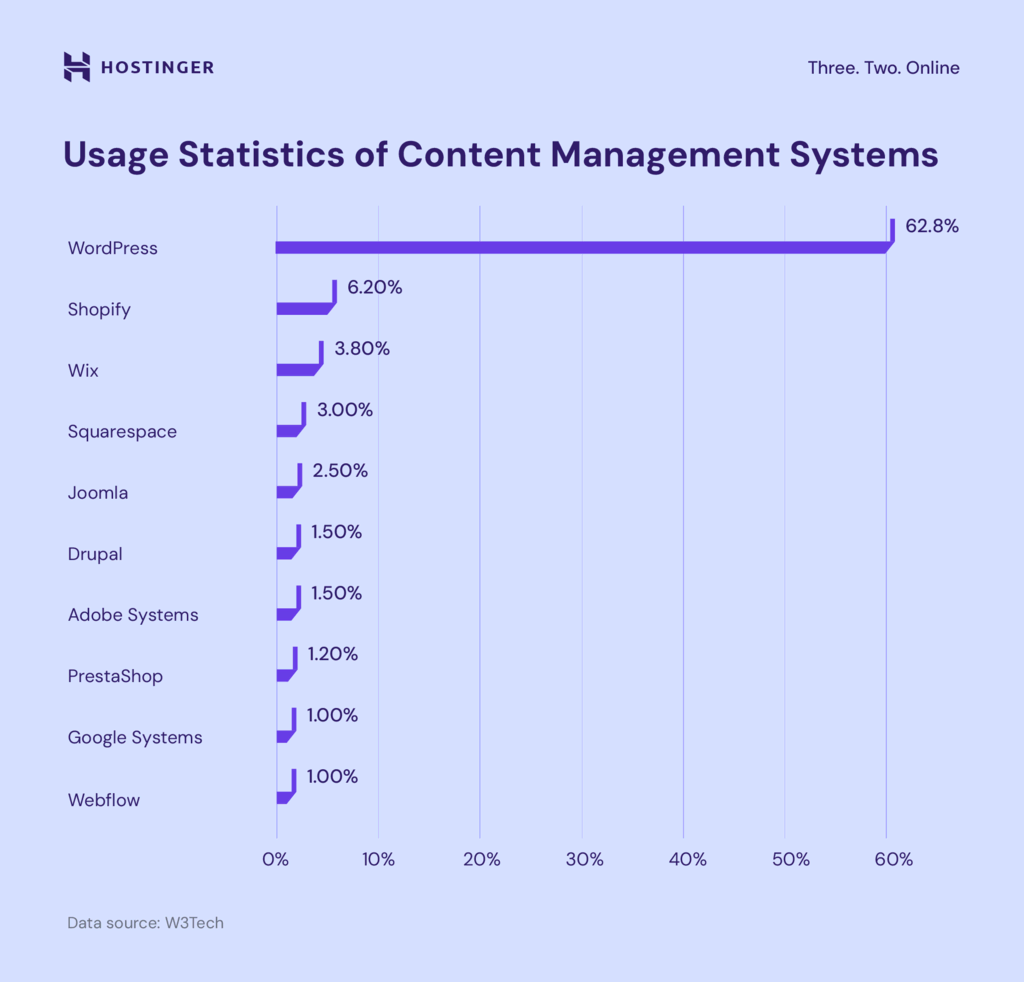
Source: Hostinger Tutorials
Key Features That Drive WordPress Growth
WordPress remains undisputed due to its standout features catering to diverse user needs. Let’s uncover the platform’s superior capabilities that drive its growth and wide adoption.
SEO Capabilities
While WordPress alone isn’t enough to achieve optimal SEO performance, it’s highly compatible with external plugins to scale your website’s search engine friendliness. Popular options that deliver exceptional SEO traffic include Yoast SEO and RankMath.
Aside from external plugin compatibility, WordPress has built-in features to fine-tune your site’s URLs, content, images, and mobile responsiveness for maximum search engine visibility. This suggests why WordPress sites account for 40% of Google’s top 10 results.
E-Commerce Capabilities
As 56.5% of customers prefer shopping online instead of in-store, e-commerce platforms are racing to attract countless customers. WooCommerce is the most popular e-commerce platform, used by 20.2% of all live WordPress sites and 8.8% of all websites.
WooCommerce is a free, open-source plugin that stays on top of the eCommerce solutions, with over 8 million installations. This can transform your WordPress site into a fully functional online store with vast features supporting 67 languages.
Designed for non-technical users, the platform is at the top of its game, making up 38.74% of the e-commerce software market share (based on the graph). Even with many platforms bursting into the scene, WooCommerce supports 31% of the top 1 million websites.
Market share of leading e-commerce software platforms and technologies worldwide as of 2023
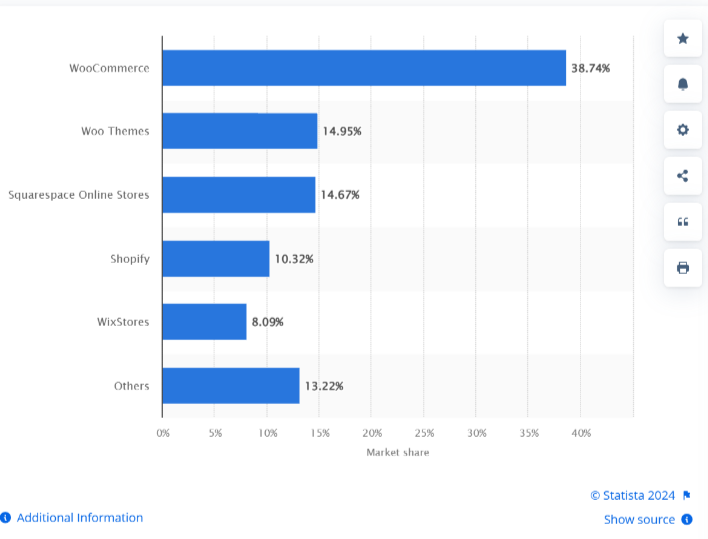
Source: Statista
Flexibility & Customisation
While you might be tired of cookie-cutter websites, WordPress offers near-unlimited customisation to express your unique brand identity. For instance, the platform’s plugins add many features to building your website to your exact vision.
While the WordPress directory offers 59,000 plugins, only 62 have hit the 1 million active installations. The most popular are website editing, writing optimisation, and security plugins.
Meanwhile, the platform also has a rich ecosystem of themes that tailors your website design to your liking. Among its 13,000 free themes, Hello Elementor is the most used, accounting for 1.55% of the top 1 million available sites. These features continuously grow with the platform’s robust community support and resources.
Statistics for websites using WordPress Themes Technology
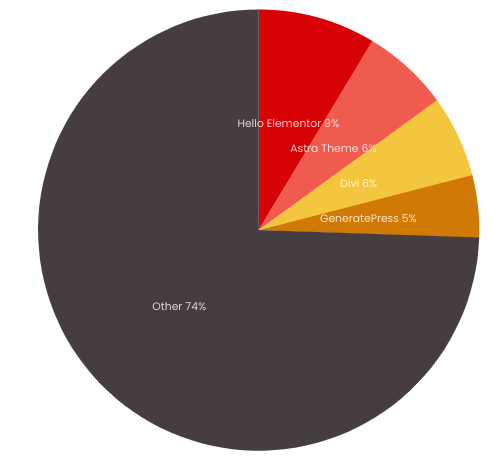
Security Features
According to Hostinger, a WordPress site is attacked every 22 minutes. Experts estimate that hacked websites could reach 13,000 sites daily. Sidestepping this vulnerability from your website is crucial to maintaining user trust and a positive brand image.
The good news is that WordPress frequently releases updates to patch vulnerabilities and improve security protocols. Its security plugins offer malware scanning, firewall protection, and two-factor authentication to circumvent potential threats.
As security threats exist in all websites, WordPress has a vigilant community that constantly monitors and reports issues, sharing best practices to mitigate risks.
Forecast: What’s Next for WordPress in 2025 and Beyond?
Can WordPress maintain its supreme reign in 2025 and beyond as rival platforms enter the digital sphere? Market forecasts show WordPress plugin market is expected to grow 2.38% annually from 2024 to 2031.
This growth fuels the platform’s efforts to stay on top of the competitive landscape. Emerging features to watch are Gutenberg’s block editor improvements, which offer advanced customisation, improved drag-and-drop functionality, and better integration with third-party apps.
As the platform enhances its AI-driven features to make content creation more intuitive, expect intelligent suggestions for SEO optimisation and content structure. AI is also crucial to automate security measures, ensuring your website remains secure and impenetrable from threats.
So, what does this mean for website owners? Investing in WordPress ensures your website remains relevant and competitive, future-proofing your online presence in the vast digital realm.
Final Thoughts
WordPress remains the world’s most popular CMS for good reason. With no sign of slowing down, it consistently grows and expands, setting the standard for web development. WordPress evolves with user demands, allowing businesses to build and grow online.
While having a powerful and flexible WordPress is key to dominating the web, authentic and valuable content that provides genuine value is what turns web visitors into paying customers.
Our experienced WordPress SEO experts at Red Search can help craft a tailored SEO strategy to take your business to the next level. Speak to us by calling 1300 101 712 or enquire online today.
Check out more related statistics through our posts below:
- Australian Mobile Phone Statistics
- Australian Local SEO Statistics
- Australian eCommerce Statistics
- Australian Internet Statistics
- Australian Buy Now & Pay Later Statistics
- Australian ChatGPT Statistics
- Australian VPN Statistics
- Australian Youtube Statistics
Frequently Asked Questions
1. How much of the web uses WordPress?
WordPress powers 43.6% of websites globally, making it the most popular CMS. That translates to two out of five websites built on the Internet.
2. Is WordPress growing or declining in usage?
Based on market forecasts, WordPress is expected to grow by 10.38% by 2028. Its popularity has consistently grown due to its flexibility, SEO capabilities, and robust community support, attracting novice and experienced web developers.
3. What is the most popular CMS?
WordPress reigns supreme among all web-building platforms, holding the largest share in the CMS market.
4. Why do businesses prefer WordPress?
Aside from its open-source nature, WordPress is highly customisable, SEO-friendly, affordable, and integrates with thousands of third-party tools that power businesses’ online presence.
Written by






